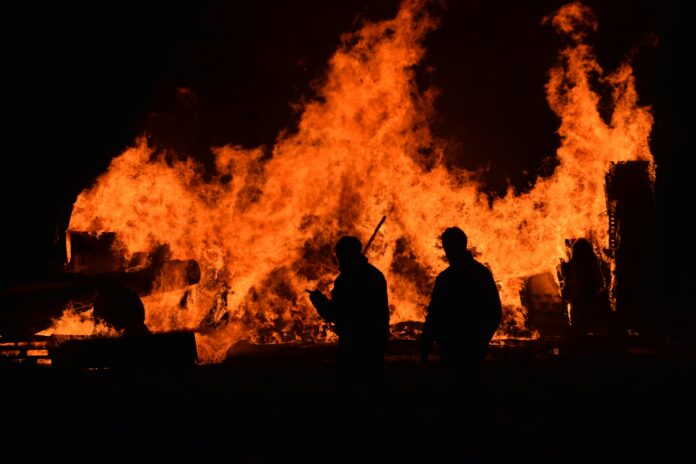419 years ago today, Guy Fawkes was caught loitering beneath the House of Lords with a pocketful of fuses and a pile of explosive dust.
A catchy rhyme and an act of Parliament have ensured that the UK has never forgotten the ill-fated Gunpowder Plot. Until 1959, it was actually illegal to ignore it: a few months after Fawkes and his co-conspirators were caught and executed, the government made November 5 a mandatory celebration.
Not that the British public needed encouragement. Since the 17th century, Bonfire Night has given revellers an excuse to fire off an arsenal of fireworks that the plotters themselves would envy. It became the UK’s most popular autumn festival in the intervening centuries, but some now worry that hundreds of years of effigy-burning is at risk.
Anecdotally, traditions like “penny for the Guy” do seem to be falling by the wayside. It’s easy to imagine the flat-capped children of the 1950s making a life-sized doll of Guy Fawkes to raise some pocket money, but it’s somehow harder to believe that today’s youth are interested in crowdfunding a sectarian voodoo doll. The same is true of bonfire toffee, the clumps of hardened treacle appetisingly referred to as “claggum” or “clack” in Scotland.
Since at least 2012, commentators have been blaming another, older autumn festival for the disappearance of Bonfire Night tradition. Halloween has captivated the British public over the last two decades, promising bigger frights and less Dickensian candy.
If the country votes with its wallet, then enthusiasm for Halloween has overtaken Bonfire Night. While the UK’s Halloween spending is set to exceed a record £770 million in 2024, three of London’s Bonfire Night firework displays have been cancelled due to high costs.
Traditionalists are quick to blame America’s influence for the loss of local tradition, claiming that imported traditions like trick-or-treating have distracted us from Bonfire Night customs (often ignoring the fact that most Halloween traditions originated in the UK).
Is Halloween really the problem, though? The close proximity of a commercialised holiday doesn’t seem to threaten New Year’s Eve, which falls six days after Christmas. 88 percent of the country celebrate Christmas, and hundreds of thousands go on to attend New Year’s Eve street parties, make resolutions, and watch Jools Holland gesticulate his way into January 1.
Bonfire Night itself isn’t at risk of being forgotten: a recent YouGov poll suggests that it is still more popular than its spookier cousin, and the Alexandra Palace firework display alone draws around 100,000 people. Questions about Bonfire Night still feature on the UK’s citizenship test, ensuring every recently-minted British person (yours truly included) is well aware of the Gunpowder Plot. As recently as last year, the NHS website recorded a 27 percent increase in visits to its burns advice page on Bonfire Night weekend – so plenty of people are celebrating at home, too.
Fireworks and bonfires appear to be safe from extinction, but customs like penny-for-the-Guy and clacky toffee do seem to be fading – not disappearing entirely. Tens of thousands still travel to Lewes each year on November 5, where 30 bonfire societies host “the only proper Bonfire Night celebration left”.
Bonfire Night has been accruing and shedding traditions since its inception, and that may not always be a bad thing. The earliest celebrations didn’t take place around a bonfire, but inside churches. Until around 1800, Guy Fawkes didn’t even play a starring role – he was drafted in as the night’s mascot when people decided it might be good to stop burning effigies of the Pope (though they still do that in Lewes, too).
Halloween – the scapegoat for Bonfire Night’s overstated downfall – has gone through an evolution of its own. What was once a Celtic harvest festival morphed with traditions surrounding the Christian All Hallow’s Day. The shrunken-head style carved turnips that were once used to ward off evil spirits are the forebears of today’s jack-o-lantern pumpkins. The costumed 16th-century “guisers” that went from house to house and sang for food cleared the path for millions of children to dress up as Iron Man and demand a bag of Haribo.
Holiday traditions like penny for the Guy are valuable, ephemeral heritage that should be protected and preserved – and are in places like Lewes. The holidays themselves aren’t static, though, and for better or worse, they evolve to reflect our cultural priorities. We may actually see a resurgence of bonfire toffee and turnip-carving amongst younger generations, with newspapers like The Guardian reporting that “Folklore customs dating back centuries are suddenly cool again with a new generation keen to connect with the planet and defy the establishment.”
Even if those latter-day rebels don’t succeed in kicking off a mass revival of the charming, strange traditions that make Bonfire Night a uniquely British celebration, there will still be thousands of people in a corner of Sussex keeping them alive. The bonfires and fireworks that erupt across the country aren’t going anywhere soon, either – I couldn’t even get tickets to my local celebration before they sold out.
And if the alarmists really are right about the disappearance of Bonfire Night tradition, Guy Fawkes makes for a pretty good Halloween costume.
Words by Alex Cohen
